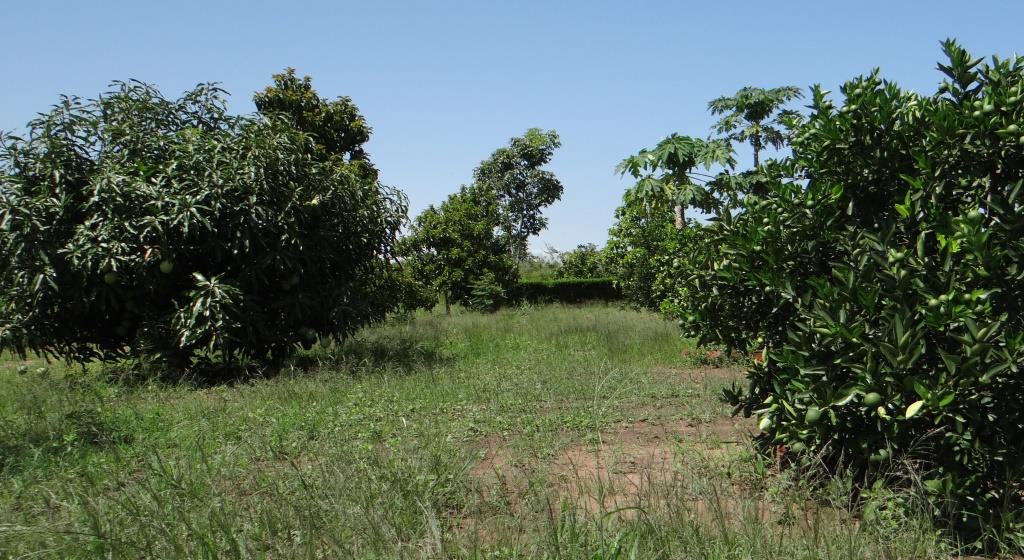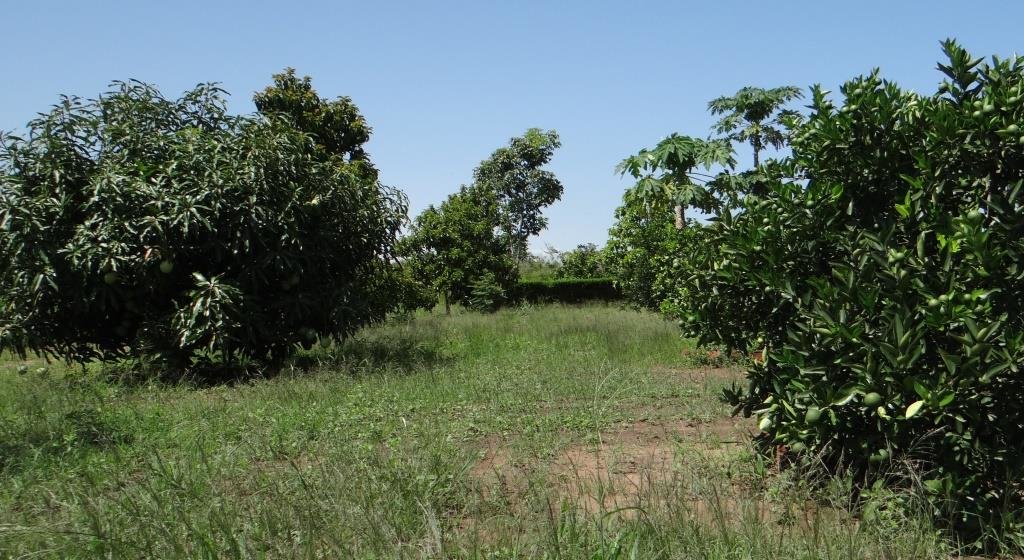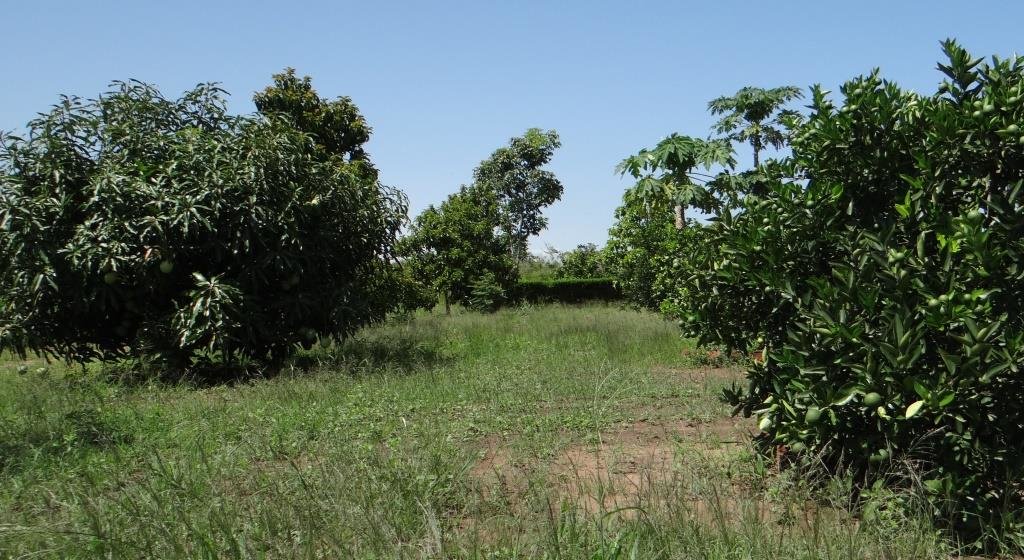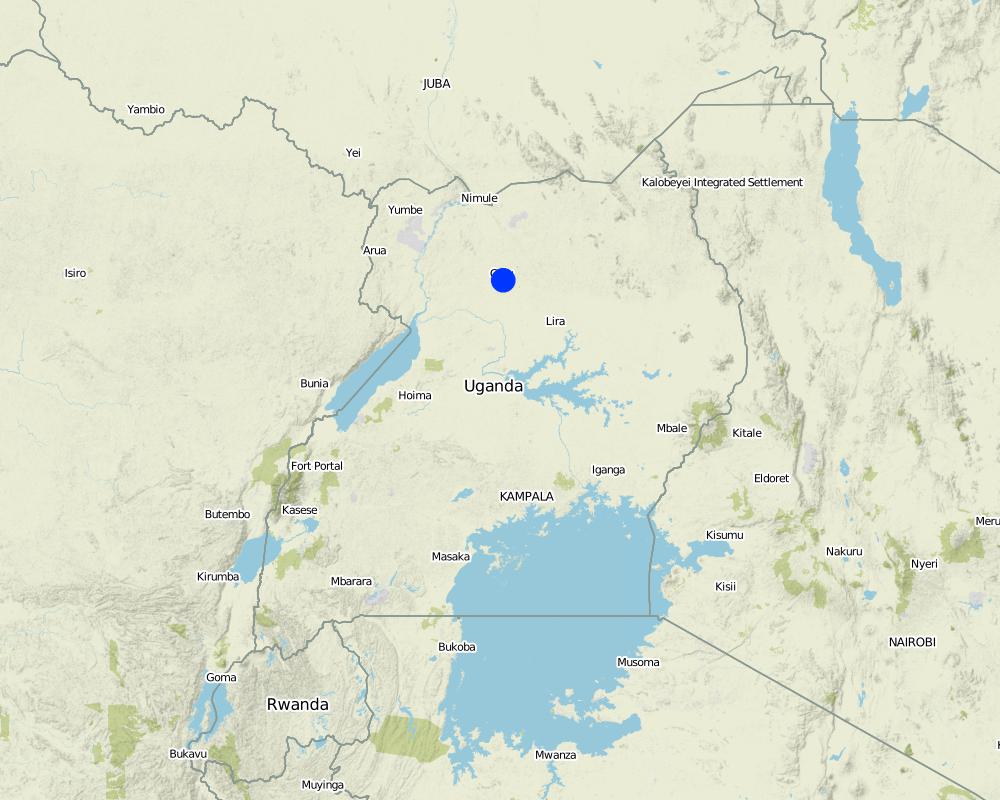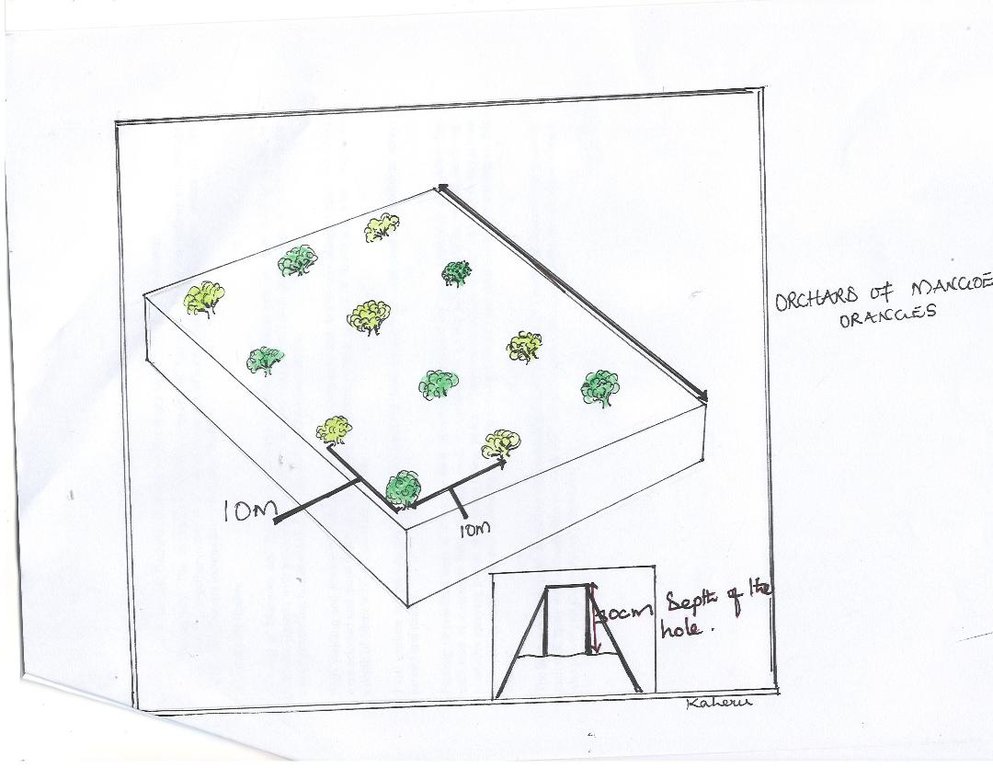Orchard of Mangoes and Oranges for Soil Fertility Improvement. [Uganda]
- Creation:
- Update:
- Compiler: Kamugisha Rick Nelson
- Editors: JOY TUKAHIRWA, Richard Otto Kawawa, Sunday Balla Amale, Bernard Fungo
- Reviewers: John Stephen Tenywa, Nicole Harari, Renate Fleiner, Stephanie Jaquet, Donia Mühlematter
Muyembe na mucungwa
technologies_2817 - Uganda
View sections
Expand all Collapse all1. General information
1.2 Contact details of resource persons and institutions involved in the assessment and documentation of the Technology
Key resource person(s)
land user:
Walter Oduour
0775296773
Gulu Development association
Gulu District
Uganda
Name of project which facilitated the documentation/ evaluation of the Technology (if relevant)
Scaling-up SLM practices by smallholder farmers (IFAD)Name of the institution(s) which facilitated the documentation/ evaluation of the Technology (if relevant)
CDE Centre for Development and Environment (CDE Centre for Development and Environment) - Switzerland1.3 Conditions regarding the use of data documented through WOCAT
When were the data compiled (in the field)?
26/05/2017
The compiler and key resource person(s) accept the conditions regarding the use of data documented through WOCAT:
Yes
1.4 Declaration on sustainability of the described Technology
Is the Technology described here problematic with regard to land degradation, so that it cannot be declared a sustainable land management technology?
No
2. Description of the SLM Technology
2.1 Short description of the Technology
Definition of the Technology:
The technology involves growing of Mangoes (Mangifera indica) and Oranges (Citrus sinensis) in the same field with the aim of conserving the environment, protecting soil from erosion, and generating income from the sale of fruits.
2.2 Detailed description of the Technology
Description:
Growing mangoes and oranges in the same field is a common sustainable land management cropping system practiced by farmers in Northern Uganda for soil fertility improvement. Under this practice farmer benefit from the litter of leaves when they fall and decompose to form manure to increase fertility of the soil. A farm located on a gentle slope of 3-5 % measuring an average size of 2-5 acres, is planted with orange varieties (Valencia and Hamlin) and mango varieties (Apple and Tommy) with the aim of generating household income and improving soil fertility litter and decomposition of the fallen leaves. The mango and orange seedlings are planted at a spacing of 10 m × 10 m in holes dug down to a depth of 30cm.
Seven to 10 workers are paid on a monthly basis and their day to day activities include establishing and maintaining the orchard; establishment entails slashing the field, digging the holes, and planting the seedlings, while maintenance entails spraying pests which attack the mangoes and oranges harvesting and marketing.
Planting more than one fruit trees in the same field increases saves use of more land which would be used for planting two fruit trees in separate gardens and saves labor since all the fruit trees are located and grown in one same field. Which in turn saves labour that would be used on two different fields. However, it is important for farmers to know that high costs are encountered at the beginning; this costs include buying seedlings, hoes, pangs, pesticides, spray pumps, and paying for labour. The costs are expected to reduce over time, leaving only costs of labour for weeding, monitoring, harvesting and marketing.
It is important for the land user to be aware that this technology is easily affected by pests and diseases. To control pests and disease, it is recommended to use dimethoiate, sprayed once every after 3 to 7 weeks.
2.3 Photos of the Technology
2.4 Videos of the Technology
Comments, short description:
Video on Orchard of Mangoes and Oranges for soil fertility Improvement in Gulu District, Northern Uganda.
Date:
26/05/2017
Location:
Gulu District
2.5 Country/ region/ locations where the Technology has been applied and which are covered by this assessment
Country:
Uganda
Region/ State/ Province:
Northern Region,Uganda
Further specification of location:
Gulu Municipality, Gulu District
Comments:
Map showing technology site of Mangoes (Mangifera indica) and Oranges (Citrus sinensis) for soil fertility Improvement.
Map
×2.6 Date of implementation
Indicate year of implementation:
2012
If precise year is not known, indicate approximate date:
- less than 10 years ago (recently)
2.7 Introduction of the Technology
Specify how the Technology was introduced:
- through projects/ external interventions
Comments (type of project, etc.):
Operation Wealth Creation (OWC) supported the farmer with seedlings.
3. Classification of the SLM Technology
3.1 Main purpose(s) of the Technology
- improve production
- reduce, prevent, restore land degradation
- mitigate climate change and its impacts
- create beneficial economic impact
3.2 Current land use type(s) where the Technology is applied

Cropland
- Annual cropping
Main crops (cash and food crops):
Maize and banana.

Mixed (crops/ grazing/ trees), incl. agroforestry
- Agroforestry
Main products/ services:
Banana.
3.3 Further information about land use
Water supply for the land on which the Technology is applied:
- rainfed
Number of growing seasons per year:
- 2
3.4 SLM group to which the Technology belongs
- agroforestry
- integrated soil fertility management
- improved plant varieties/ animal breeds
3.5 Spread of the Technology
Specify the spread of the Technology:
- evenly spread over an area
If the Technology is evenly spread over an area, indicate approximate area covered:
- < 0.1 km2 (10 ha)
3.6 SLM measures comprising the Technology

agronomic measures
- A1: Vegetation/ soil cover
- A2: Organic matter/ soil fertility
- A3: Soil surface treatment
- A5: Seed management, improved varieties

structural measures
- S11: Others

management measures
- M1: Change of land use type
- M2: Change of management/ intensity level
- M4: Major change in timing of activities
Comments:
S11-Holes where mangoes and oranges are planted.
3.7 Main types of land degradation addressed by the Technology

soil erosion by water
- Wt: loss of topsoil/ surface erosion

soil erosion by wind
- Et: loss of topsoil

chemical soil deterioration
- Cn: fertility decline and reduced organic matter content (not caused by erosion)

biological degradation
- Bc: reduction of vegetation cover
- Bs: quality and species composition/ diversity decline
- Bp: increase of pests/ diseases, loss of predators

water degradation
3.8 Prevention, reduction, or restoration of land degradation
Specify the goal of the Technology with regard to land degradation:
- prevent land degradation
- reduce land degradation
4. Technical specifications, implementation activities, inputs, and costs
4.1 Technical drawing of the Technology
4.2 Technical specifications/ explanations of technical drawing
The technical drawing shows a fruit tree farm located on a gentle slope of 3-5 % measuring an average size of 2-5 acres planted with high yielding and marketable orange varieties (Valencia and Hamlin) and mango varieties (Apple and Tommy) with the aim of generating household income and improving soil fertility. The mango and orange seedlings are planted at a spacing of 10 m × 10 m in holes dug down to a depth of 30 cm supported by seven to 10 workers who are paid on a monthly basis to support establishment and management activities.
4.3 General information regarding the calculation of inputs and costs
Specify how costs and inputs were calculated:
- per Technology area
other/ national currency (specify):
UGX
Indicate exchange rate from USD to local currency (if relevant): 1 USD =:
3400.0
Indicate average wage cost of hired labour per day:
5000
4.4 Establishment activities
| Activity | Type of measure | Timing | |
|---|---|---|---|
| 1. | Site / field selection | Agronomic | Once before establishment |
| 2. | Slashing the field | Vegetative | Once before establishment |
| 3. | Look for labour | Other measures | Before establishment |
| 4. | Select for seedlings | Agronomic | Before establishment |
| 5. | Dig the hole | Structural | During establishment |
| 6. | Plant the seedlings | Agronomic | Before estabslishment |
| 7. | Management | After establishment |
4.5 Costs and inputs needed for establishment
| Specify input | Unit | Quantity | Costs per Unit | Total costs per input | % of costs borne by land users | |
|---|---|---|---|---|---|---|
| Labour | Persons days on monthly basis | Persons | 8.0 | 100000.0 | 800000.0 | 100.0 |
| Equipment | Hoes | Pieces | 4.0 | 10000.0 | 40000.0 | 100.0 |
| Equipment | Pangas | Pieces | 4.0 | 7000.0 | 28000.0 | |
| Equipment | Spraying pumps | Pieces | 2.0 | 250000.0 | 500000.0 | |
| Plant material | Seedlings | seedling | 1000.0 | 2500.0 | 2500000.0 | |
| Fertilizers and biocides | Pestcides | litres | 3.0 | 10000.0 | 30000.0 | 100.0 |
| Construction material | 100.0 | |||||
| Total costs for establishment of the Technology | 3898000.0 | |||||
4.6 Maintenance/ recurrent activities
| Activity | Type of measure | Timing/ frequency | |
|---|---|---|---|
| 1. | Slashing | Agronomic | Twice a year |
4.7 Costs and inputs needed for maintenance/ recurrent activities (per year)
| Specify input | Unit | Quantity | Costs per Unit | Total costs per input | % of costs borne by land users | |
|---|---|---|---|---|---|---|
| Labour | Persons days on monthly basis | Persons | 2.0 | 100000.0 | 200000.0 | 100.0 |
| Labour | labour for weeding daily basis | Persons | 2.0 | 5000.0 | 10000.0 | 100.0 |
| Fertilizers and biocides | Pestcide | Litres | 4.0 | 13000.0 | 52000.0 | |
| Total costs for maintenance of the Technology | 262000.0 | |||||
4.8 Most important factors affecting the costs
Describe the most determinate factors affecting the costs:
Labour for planting, weeding , slashing and spraying take the most costs.
5. Natural and human environment
5.1 Climate
Annual rainfall
- < 250 mm
- 251-500 mm
- 501-750 mm
- 751-1,000 mm
- 1,001-1,500 mm
- 1,501-2,000 mm
- 2,001-3,000 mm
- 3,001-4,000 mm
- > 4,000 mm
Specify average annual rainfall (if known), in mm:
1400.00
Specifications/ comments on rainfall:
Two rainy season (March- may) and September to November.
Agro-climatic zone
- sub-humid
5.2 Topography
Slopes on average:
- flat (0-2%)
- gentle (3-5%)
- moderate (6-10%)
- rolling (11-15%)
- hilly (16-30%)
- steep (31-60%)
- very steep (>60%)
Landforms:
- plateau/plains
- ridges
- mountain slopes
- hill slopes
- footslopes
- valley floors
Altitudinal zone:
- 0-100 m a.s.l.
- 101-500 m a.s.l.
- 501-1,000 m a.s.l.
- 1,001-1,500 m a.s.l.
- 1,501-2,000 m a.s.l.
- 2,001-2,500 m a.s.l.
- 2,501-3,000 m a.s.l.
- 3,001-4,000 m a.s.l.
- > 4,000 m a.s.l.
Indicate if the Technology is specifically applied in:
- not relevant
5.3 Soils
Soil depth on average:
- very shallow (0-20 cm)
- shallow (21-50 cm)
- moderately deep (51-80 cm)
- deep (81-120 cm)
- very deep (> 120 cm)
Soil texture (topsoil):
- coarse/ light (sandy)
- medium (loamy, silty)
Soil texture (> 20 cm below surface):
- coarse/ light (sandy)
- medium (loamy, silty)
Topsoil organic matter:
- high (>3%)
- medium (1-3%)
If available, attach full soil description or specify the available information, e.g. soil type, soil PH/ acidity, Cation Exchange Capacity, nitrogen, salinity etc.
Top soil organic matter is high due to because when leaves litter they rot and decompose and form manure which improves fertility , and sometimes when oranges and mangoes fall on the ground and are not picked by the farmer due to high production, they rot and decompose and improve the organic matter.
5.4 Water availability and quality
Ground water table:
< 5 m
Availability of surface water:
medium
Water quality (untreated):
good drinking water
Is water salinity a problem?
No
Is flooding of the area occurring?
No
5.5 Biodiversity
Species diversity:
- medium
Habitat diversity:
- medium
5.6 Characteristics of land users applying the Technology
Sedentary or nomadic:
- Sedentary
Market orientation of production system:
- commercial/ market
Off-farm income:
- less than 10% of all income
Relative level of wealth:
- average
Individuals or groups:
- individual/ household
Level of mechanization:
- manual work
- mechanized/ motorized
Gender:
- women
- men
Age of land users:
- youth
- middle-aged
5.7 Average area of land owned or leased by land users applying the Technology
- < 0.5 ha
- 0.5-1 ha
- 1-2 ha
- 2-5 ha
- 5-15 ha
- 15-50 ha
- 50-100 ha
- 100-500 ha
- 500-1,000 ha
- 1,000-10,000 ha
- > 10,000 ha
Is this considered small-, medium- or large-scale (referring to local context)?
- medium-scale
5.8 Land ownership, land use rights, and water use rights
Land ownership:
- individual, not titled
Land use rights:
- individual
Water use rights:
- individual
5.9 Access to services and infrastructure
health:
- poor
- moderate
- good
education:
- poor
- moderate
- good
technical assistance:
- poor
- moderate
- good
employment (e.g. off-farm):
- poor
- moderate
- good
markets:
- poor
- moderate
- good
energy:
- poor
- moderate
- good
roads and transport:
- poor
- moderate
- good
drinking water and sanitation:
- poor
- moderate
- good
financial services:
- poor
- moderate
- good
6. Impacts and concluding statements
6.1 On-site impacts the Technology has shown
Socio-economic impacts
Production
crop production
crop quality
land management
Income and costs
expenses on agricultural inputs
Comments/ specify:
High due to purchase seedlings, labour, fertilizer costs during the short run but reducing in the long run.
farm income
Comments/ specify:
From the sale of mangoes and oranges.
workload
Socio-cultural impacts
SLM/ land degradation knowledge
6.2 Off-site impacts the Technology has shown
water availability
6.3 Exposure and sensitivity of the Technology to gradual climate change and climate-related extremes/ disasters (as perceived by land users)
Gradual climate change
Gradual climate change
| Season | Type of climatic change/ extreme | How does the Technology cope with it? | |
|---|---|---|---|
| annual temperature | increase | moderately | |
| seasonal temperature | wet/ rainy season | decrease | moderately |
| annual rainfall | increase | well | |
| seasonal rainfall | wet/ rainy season | increase | moderately |
Climate-related extremes (disasters)
Climatological disasters
| How does the Technology cope with it? | |
|---|---|
| land fire | not well |
Hydrological disasters
| How does the Technology cope with it? | |
|---|---|
| landslide | well |
Comments:
Growing of mangoes and oranges in the field can be affected by fire outbreaks and good at reducing erosion and land slides.
6.4 Cost-benefit analysis
How do the benefits compare with the establishment costs (from land users’ perspective)?
Short-term returns:
slightly positive
Long-term returns:
positive
How do the benefits compare with the maintenance/ recurrent costs (from land users' perspective)?
Short-term returns:
very positive
Long-term returns:
very positive
6.5 Adoption of the Technology
- 1-10%
Of all those who have adopted the Technology, how many have did so spontaneously, i.e. without receiving any material incentives/ payments?
- 0-10%
Comments:
More land users are interested in the technology but capital to buy seedlings is a problem.
6.6 Adaptation
Has the Technology been modified recently to adapt to changing conditions?
No
6.7 Strengths/ advantages/ opportunities of the Technology
| Strengths/ advantages/ opportunities in the land user’s view |
|---|
| East to manage on farm. |
| Cost effective: Returns are high if managed well. |
| Controls soil erosion; Good at reducing soil erosion. |
| Creates employment for many people and it is good at providing income after sale of fruits. |
| Strengths/ advantages/ opportunities in the compiler’s or other key resource person’s view |
|---|
| Its replicable; it can be used by both small and large scale land users. |
6.8 Weaknesses/ disadvantages/ risks of the Technology and ways of overcoming them
| Weaknesses/ disadvantages/ risks in the land user’s view | How can they be overcome? |
|---|---|
| Appropriate to the rich only; Inputs are expensive. | Link the small scale land users to credit institutions with less interest rates to pay back later after selling their products. |
| Weaknesses/ disadvantages/ risks in the compiler’s or other key resource person’s view | How can they be overcome? |
|---|---|
| Risky in case of pests and diseases; Low returns-low income. | On site training in pests and disease management. |
7. References and links
7.1 Methods/ sources of information
- field visits, field surveys
1
- interviews with land users
1
Links and modules
Expand all Collapse allLinks
No links
Modules
No modules


